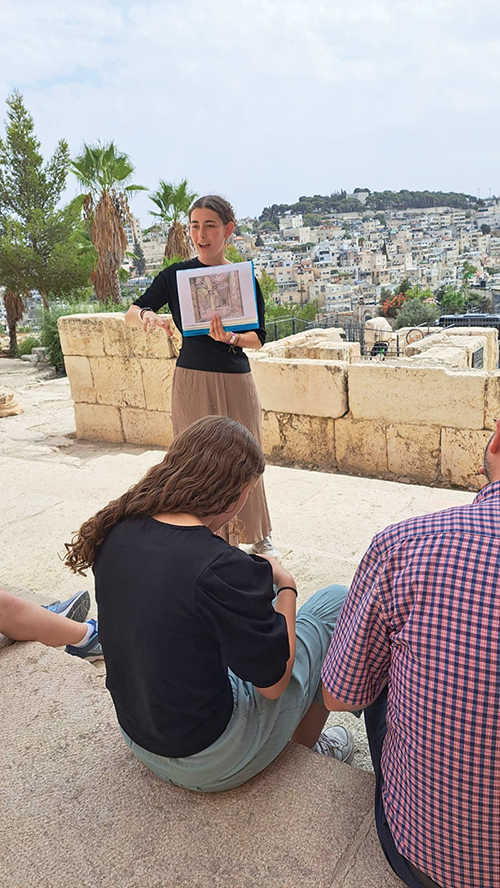
Pesach is the paradigm of redemption in our history—the hand of God coming to rescue us from our oppressors. But Pesach is just one of many examples—Nach is littered with such stories, many of which I relive every day as a tour guide in the Rova.
After the exile of the Kingdom of Israel towards the end of the First Beit Hamikdash, King Hezekiah of Judah decided to purify the Beit Hamikdash, and unite the Jews that were still left in Israel. This was all well and good, until he decided to stop paying taxes to the Assyrians who controlled the region—he was but a local king, beholden to their imperial laws.
Knowing that Sancheireb’s Assyrian army would soon arrive to punish Judah for their delinquency, King Hezekiah began to prepare for the imminent siege of Jerusalem (the first of over 20 sieges in her history). He brought the local water source inside of the walls of the city, stocked up on food, and built a wall around the parts of the city that were exposed. Jerusalem had grown dramatically since the time of David and Shlomo, and the walls had not yet been expanded to accommodate the population growth.
When Sancheireb’s army arrived, his soldiers began to climb up onto Hezekiah’s wall, and shout down at the Jews inside the city, “You have no chance, you’re all going to die; you may as well give up now. Every nation that we’ve defeated has prayed to their gods, but none of them have helped them—why would yours be any different?”
The Jews were terrified. But King Hezekiah decided to daven in the newly purified Beit Hamikdash.
As described in Nach (Melachim 2, 18 & Divrei Hayamim 2, 32), Sancheireb’s army went to bed that night, and didn’t wake up the next morning. Similar to Maakat Bechorot, an angel of God (admittedly not God himself this time) entered the camp, and killed them in their sleep. The pasuk uses the word “vayikached,” found throughout Tanach (including in the Pesach story) to mean complete annihilation. Only Sancheireb survived—he ran back to Assyria in defeat, and was ironically killed while hiding in the temple of one of his own gods.
Incredibly, unlike the miracles of the makkot, firsthand testimony of this story is still visible today in the heart of the Rova, the Jewish Quarter of the Old City. King Hezekiah’s wall still stands, and the newly built visitors’ center (set to open later this year) allows one to feel as if they are standing on the wall, like Sancheireb’s soldiers did almost 3,000 years ago. I have the unique privilege of giving tours of the Old City, including Hezkiah’s Wall, as part of my national service. The Rova is full of incredible historical sites, each with their own story; in some there are open miracles like that of Hezekiah’s Wall, and in others, God’s involvement is more hidden. However, they all come together to make up the patchwork that is the history of our people. And special for this Pesach break, we will be having a Pesach festival throughout the Rova, including live music, and free admission to all of our sites for people who reserve through this article. If you will be in the Old City over the coming weeks, I encourage you to leave some time before or after your visit to the Kotel to experience this patchwork of our history firsthand—the Rova is so much more than just the way to the Kotel.

I think that this year especially, the idea of open miracles, of revealed redemption, is incredibly attractive. Attractive because we just marked six months of this war, six months that our brothers and sisters sit captive as hostages, that our cousins continue to be agunahs, that hundreds of our relatives are displaced from their homes, that our family is in a deep state of mourning. Where are you, God? Please come now and end this.
But do we dare to hope? Are we worthy of our enemies being completely annihilated as they were in the Pesach story and in the time of King Hezekiah?
I wish I knew. But in both the Pesach story and in the story of King Hezekiah, a couple of things stick out: unity of Am Yisrael, and help coming unequivocally from God Himself in response to our enemies doubting His rulership. Having lived in Israel for the past six months, I can report that the unity here is at an all-time high. And though I had been hearing from family and friends back in the US that chutz laaretz Jews are also incredibly united right now, always with Israel in your hearts, I was incredibly touched on a recent trip to NY/NJ to see just how true this continues to be. Thank you for your tehillim after every tefilah, for your Avinu Malkenus, and for your acknowledgements at every event, from weddings to dinners to bat mitzvahs (all of which I was zocheh to be at in the U.S. over the last couple of weeks). I knew that I grew up in an incredible community, but seeing all of this first hand made me cry every single time. Know that the Jews of Israel are standing with you as antisemitism continues to rise—we are horrified by the pro-Hamas protests of the last six months.
May we soon see His revealed might as our Protector once again as a result of the beautiful unity of the Jewish people.
Meira Shapiro grew up in Bergenfield. She went to Maayanot for high school and made aliyah in 2022 while in shana alef at Migdal Oz. She now does Sherut Leumi (national service) as a tour guide in the Jewish Quarter under the Travel Rova tourism department. For more information on upcoming tours, see https://travelrova.co.il/language/en/home/.











